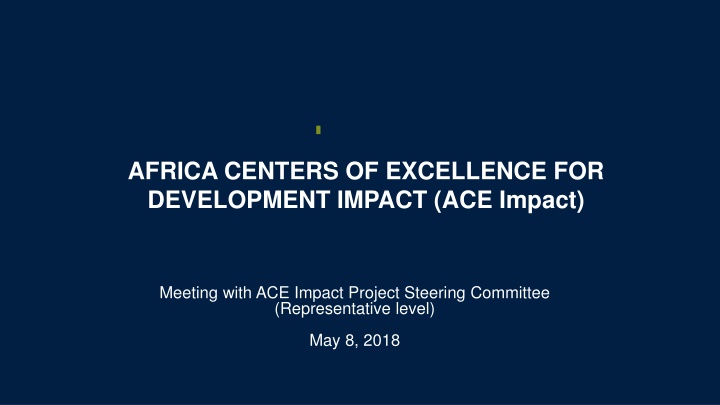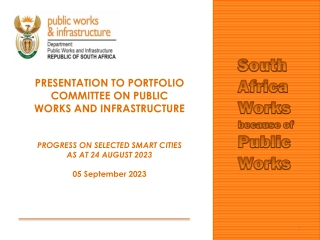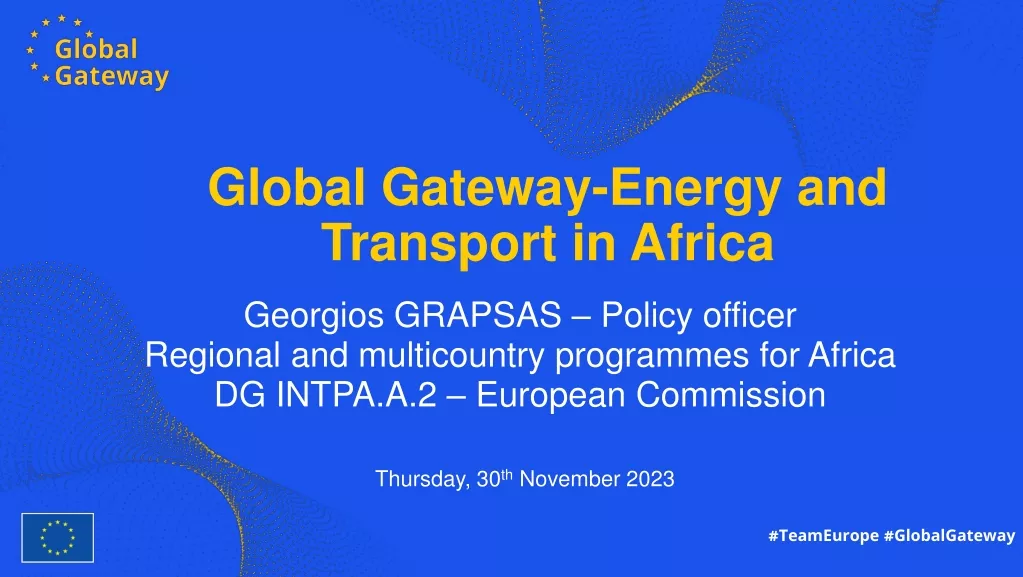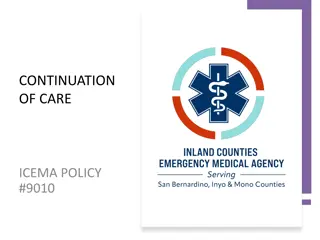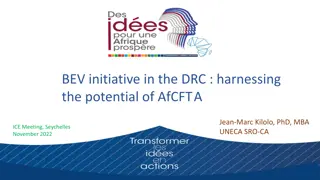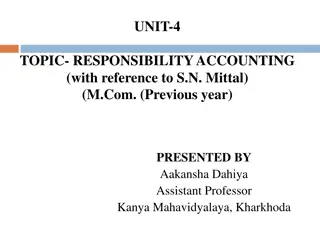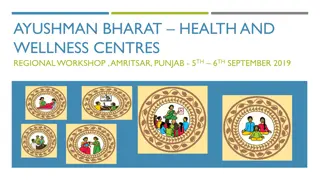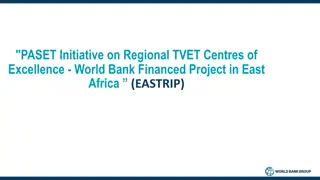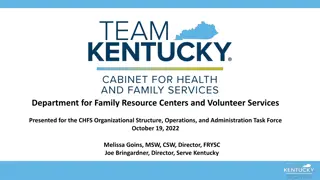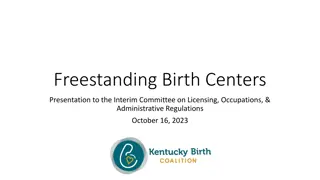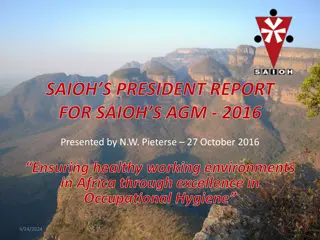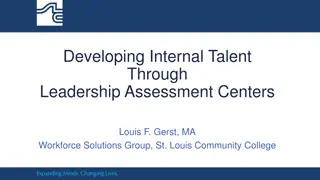Overview of Africa Centers of Excellence Initiative
The Africa Centers of Excellence (ACE) initiative aims to address regional development challenges through specialized training and research. It involves multiple countries and focuses on quality education, impactful research, and industry collaboration. The project's uniqueness lies in its international selection mechanism and results-based financing model, ensuring accountability for achieving excellence in higher education. Detailed information includes project objectives, funding allocation, partnership details, and disbursement rates by country.
Download Presentation

Please find below an Image/Link to download the presentation.
The content on the website is provided AS IS for your information and personal use only. It may not be sold, licensed, or shared on other websites without obtaining consent from the author.If you encounter any issues during the download, it is possible that the publisher has removed the file from their server.
You are allowed to download the files provided on this website for personal or commercial use, subject to the condition that they are used lawfully. All files are the property of their respective owners.
The content on the website is provided AS IS for your information and personal use only. It may not be sold, licensed, or shared on other websites without obtaining consent from the author.
E N D
Presentation Transcript
AFRICA CENTERS OF EXCELLENCE FOR DEVELOPMENT IMPACT (ACE Impact) Meeting with ACE Impact Project Steering Committee (Representative level) May 8, 2018
Africa Centers of Excellence (ACE I- first phase) 2
Outline Africa Centers of Excellence (ACE I- first phase) ACE Impact Project Overview (New phase) Objectives Project Components (features, activities, results, indicators) Implementation arrangements Status: Fund allocation by country Timeline Partnerships
ACE I Objectives Western and Central Africa ACE 1 launched in April 2014 with funding envelope $165million Project Development Objective is : to have regional specialization in areas that address specific common regional development challenges deliver high quality training and applied research meet the demand for skills required for Africa's development Component 1: Benin, Burkina Faso, Cote d Ivoire, Cameroon, Ghana, Nigeria, Senegal, Togo 22 centers across 8 countries Component 2: The Gambia The Gambia has $3 million to send its students to the 22 centers Regional Facilitation Unit is the Association of African Universities Aggregated M&E, regional facilitation of steering committee and supervision and technical assistance to the centers 5
Uniqueness of the ACE model 2 First ever regional higher education competition using international selection mechanism The project is financed based on results achieved by each ACE. Regional Bodies 9 Participating Countries 22 Number of ACEs The results center on achievement of quality and impactful education and research excellence Enrolling masters and PhD students Publishing in international peer reviewed journals Quality benchmarks including international accreditation Internship of students in industry Revenue generation 6
ACE Disbursement Planned disbursement (based on expected results) by June 30 ACE DISBURSEMENT BY COUNTRY 100% Disbursement Rate as of April 2018 90% Country Gambia Nigeria Senegal Burkina Faso Benin Cameroon Ghana Togo Cote d'Ivoire AAU project wise 80% 93% 57% 47% 75% 35% 31% 72% 40% 26% 91% 54% 95% 65% 52% 80% 45% 40% 75% 50% 35% 93% 60% 70% 60% 50% 40% 30% 20% 10% 0% May-15 Nov-15 May-16 Nov-16 May-17 Aug-17 Oct-17 Apr-18 Gambia Benin Cote d'Ivoire Nigeria Cameroon AAU Senegal Ghana project wise Burkina Faso Togo 7
ACE Implementation Progress ACE Implementation Progress 80% 70% 60% 50% 40% 30% 20% 10% 0% Results achieved Total funds used to date/ Total Grant (%) Resutls and Expenditure Average 8
ACE I is on Track to Achieve ALL 5 Project Development Objective (PDO) Indicators Cumulative Results 2017 PAD Baseline PAD target Year 3 Status ACE PDO INDICATORS Project Development Objective Indicators No. of national and regional students (Msc, Phd and short term) No. of Regional students (Msc, Phd and short term) No. of internationally accredited education programs 1,580 9,500 15,657 Achieved 987 5,300 4,987 On track 3 10 12 Achieved No. of Students and faculty with at least 1 month internship in a company or a local institution relevant to their field Amount of externally generated revenue 35 new Master and Phd programs-e.g Master s in Seed Technology at WACCI-Ghana 1600 PhD students 6,800 Msc students 1,037 4,300 3,448 On track 976877 5,000,000 29,000,000 Achieved 9
Nigeria-Center of Excellence in Oilfield Chemicals Research (CEFOR) 70 new PhD students admitted for the 2016/2017 session 208 M.Sc. students graduated Strong University/industry-partnership efforts Center s laboratory facilities. 2-storey building to house the ACE-CEFOR Commissioning of NLNG Centre/mini-modular refinery First International Conference on Oilfield Chemistry and Flow Assurance (Oilflow -2015) 12 post graduate programmes received national accreditation from the NUC for in April 2017 The Center carried out an international accreditation gap analysis in June 2017. 10
ACE Impact Project Overview (New phase) 11
Lessons Learned A need to select centers tied to clearly defined development challenges Good quality and strategic proposals, addressing national and regional challenges of economic/development relevance A need for stronger upfront industry/sectoral engagement/commitment A need for strong institutional and country ownership Opportunity for institutional impact with appropriate incentives Strengthen regional networks Upfront capacity building, outreach and coordination to accelerate performance Leverage funding within the project SELECTING THE RIGHT TEAM, RIGHT PARTNERS AND THE RIGHT TERMS OF REFERENCE TO ADDRESS DEVELOPMENT CHALLENGES 12
Objective of the ACE Impact Project To improve quantity, quality and development impact of post-graduate education in selected universities through regional specialization Improve quantity of enrolled students (ultimately graduates) in post-graduate programs (Master s, PhDs) Improve quality of post-graduate programs such that students acquire the necessary theoretical knowledge and applied skills upon graduating Improve development Impact such that the knowledge from research and skills acquired by graduates are directly impacting development challenges Project duration 4 to 5 years
Development Impact Objective: To address in concrete ways the skills shortage and knowledge needs associated with a Development Challenge Africa Centers of Excellence for Development Impact (ACE Impact) The Role of Industry or Sectoral Partners (strengthened compared to ACE 1) Initial interviews to guide proposal development Contributing to the center (curricula, internships, hiring graduates, IAB, applied research and services) Tools to measure Impact Evaluation and selection process DLIs IAB Take up of knowledge and hiring of graduates contribute to long-term impact
Institutional Impact Objective: To use the tools available via the ACE project to bring about positive changes in the ACE host institutions Tools to measure Institutional Impact Evaluation and selection process DLIs DLIs under consideration include Endorsement of university wide regional strategy for higher education. Undertaking competitive selection of department heads and university management Institutional wide international accreditation University wide external audit Participating in the Regional Benchmarking: submitting data on required indicators and implementing interventions to improve their performance ACEs cannot exist as oasis of excellence but should influence change in their broader institutions
Industry Engagement Committed financial support for the proposed Center from industry and sectoral partners Centers will develop plans through which industry can contribute to developing and undertaking the research activities of the proposed Center Use of employment data and industry/sectoral input in program development Industry engagement in curriculum development Internship and hiring opportunities Uptake of applied research by industry Centers will constitute Industry Advisory Board composed of regional industry and sectoral leaders in the sector of the proposed Center Strong involvement of industry from proposal development stage and throughout implementation
Components Component 1 (US$ 140 180 million) Component 3 (US$ 15 30 million) Component 2 (US$ 75 95 million) Component 3: Support for: Subcomponent 1.1: Support to establish new centers of excellence Subcomponent 2.1: Support to emerging centers of excellence for networking, regional TA and improving learning environment -Regional Higher Education policymaking and collaboration Subcomponent 1.2: Support to scale-up well performing centers of excellence (renewals) -Regional project facilitation (including M&E) Subcomponent 2.2 (optional): Support for PhD scholarships (i) PASET Regional Scholarship & Innovation Fund and (ii) National priority scholarships Subcomponent 1.3: Support to scale-up of Colleges of Engineering & Technology
New Centers (Component 1.1) Objective: To deliver top quality postgraduate education (skills) and applied research to address regional development challenges, attractive to regional students, faculty, industry and international partners. Activities to be funded Equipment purchase & buildings Faculty training Partnerships & industry outreach Institutional improvement Program redesign and accreditation Increasing enrollment and retention of female students/faculty Scholarships for students On-line learning courses Project management Features Disbursement of funds to centers are linked to results achieved (DLIs). ~ 15-25 new centers will be competitively selected ~ Half will be in pre-identified priority sectors ~ US$ 4-6 million per center Potential to become a regional hub in the ACE s specialized area 18
New Centers (Component 1.1): Proposed Results & Indicators Focus of improvement: Funding linked to results (DLRs): No. of newly enrolled postgraduate students No. of ACE related research publications Amt. in externally generated revenue No. of newly accredited programs New facilities/equipment No. of faculty and students in internships Institutional impact (governance and regionalization) Financial management (timeliness and transparency) International quality post-graduate education Increased enrollment and better retention of women Targeted research in response to development challenges Much stronger Industry engagement Increased strategic/ functional regional and international partnerships Strengthened Institutional-level Impact Improved attention to student affairs Sustainable (revenue generation) 19
Renewals of existing ACEs (Component 1.2) Objective: To support well performing ACEs to scale up delivery of top quality postgraduate education (skills) and applied research to address regional development challenges, attractive to regional students, faculty, industry and international partners. Activities to be funded Equipment purchase & buildings (less compared to 1.1) Partnerships & Industry outreach Institutional improvement Program redesign and accreditation Scholarships for students Increasing enrollment and retention of female students/faculty On-line learning courses Project management Features Disbursement of funds to centers are linked to results achieved (DLIs). ~7-10 of the top performing centers will be competitively selected All current ACE 1 sectors are eligible US$ 3-4 million per center (based on discipline) Be ready to be a regional hub in the ACE s specialized area 20
Renewals (Component 1.2): Proposed Results & Indicators Focus of improvement: Similar to current ACE I but more emphasis on: Funding linked to results (DLRs): Similar to the DLRs for the new centers (component 1.1), covering: Enrollment Research publication Accreditation of programs Civil works and equipment (purchased, installed, in-use) Internships, externally generated revenue Institutional impact Scale up postgraduate education Much stronger industry partners Strengthened Institutional-level Impact Professionalize regionalization Accreditation Increased enrollment and better retention of women Sustainability Greater funding weight on institutional impact, regional networking and industry/sectoral engagement 21
Pre-Identified Regional Development Challenges Broad Themes Sectors Applied Sciences, Engineering, Technology Energy (power) Information and Communications Technology (Big Data) Water Strongly linked to demand expressed by stakeholders working in the region Terms of reference have been drafted for the different sectors highlighting the skills and applied research gaps Health Nursing and Professional health trainers Education Education STEM / Excellence in teacher training Further consultations will be held with relevant industry/sectoral leaders Environment Environment - Costal Resilience Environmental science and applied Impact assessment The best proposal within the priority will be selected Urbanization and Transport Transport logistics (policies, economics, urban planning, traffic management, ICT etc.) Urban Planning and Design Housing/Land Development Around half of the centers selected could be in targeted areas (max. 10 priority challenges) Others Quantitative Economics 22
Scale-up of Colleges of Engineering & Technology (Component 1.3) Objective: To super-size the institutional impact at universities hosting ACE Impact centers 4-5 engineering ACE could receive additional financing ($4-6 million) to support a broader strengthening of the College of Engineering Interventions should be coupled to ACE center activities, and must focus on institutional impact Entrepreneurship, innovation and business programs Enhanced teaching and research capacity New/strengthened programs synergistic to ACE Center Institutional transformation in policies and procedures No additional proposal required based on expert evaluators conducting on-site visits and expert panel Pending availability of funds, quality of institutions, and government approval 23
Emerging Centers/Programs (Component 2.1) Objective: To build national capacity and strengthen regional networking of emerging centers (a department or multi-disciplinary center). Eligibility: Countries with no prior ACE center Features Activities to be funded Equipment purchase & buildings Targeted to national undergraduate and postgraduate education topics of regional need Developed in conjunction with national priority and Development Challenge Must partner with Africa Center of Excellence (50% of budget and DLIs) To strengthen regional academic networks To benefit from technical assistance Enhanced teaching and research capacity Noncompetitive process ($4-6 million) with proposals due after ACE Impact selection Regional partnership activities with Component 1 ACE Impact, ACE I and ACE II centers Institutional improvement Industry outreach Faculty training Program redesign and development (education/research) and accreditation Scholarships for students 24
Emerging Centers (Component 2.1): Proposed Results & Indicators Funding linked to results (DLRs): Focus of improvement: No. of newly enrolled students No. of newly developed or revamped programs No. of newly accredited programs New facilities/equipment completed No. of faculty and students in internships Institutional impact (governance and regionalization) Financial management (timeliness and transparency) Strengthened undergraduate and postgraduate education & research capacity (facilities and faculty) Stronger alignment with industry needs Strengthened Institutional-level Impact Targeted regional networks Accreditation Increased enrollment and better retention of women Sustainability These centers will receive additional proposal writing support 25
National Priority Scholarships for ACEs (Component 2.2 - proposal) Objective: To support more Ph.D. students in strategic areas of national need Expanded version of the ACE 1 Gambia Model Benefitting from ACE Impact regional excellence Strengthening long-term academic networking Scholarships for Ph.D. students in strategic areas of national demand National governments identify candidates (non-Ph.D. faculty members) Expected to return to current institution upon completion of degree Proposed age limit at start of program (Male 32; Female 35) Participants earn Ph.D. at ACE centers *RSIF is regional selection competition. NPS allows national governments to strategically select candidates 26
PASET - RSIF (Component 2.2 - Optional) Objective: Contribute to regional public goods by creating highly skilled applied science, engineering and technology professionals and knowledge relevant to transformative technologies that can help to address critical and common development challenges as well as boost private sector productivity. Contributors African governments; 5 countries have committed, of which two have transferred funds. Another 5 countries have made commitments in principle. Countries can opt to use IDA credit to contribute to the fund ($ 2 million) and leverage an equivalent amount in regional credit) RSIF will operate through a General Fund and an Endowment (permanent) Fund Countries with firm commitments by heads of state: Ethiopia, Kenya, Rwanda, Senegal and Cote d Ivoire. Kenya and Rwanda have transferred funds Has 3 windows: Scholarships for PhD students Research grants for scholars who have completed PhDs and for faculty engaged in doctoral training Innovation grants for faculty, scholars and researchers Donors. Korea has made a commitment of $ 10 million to the RSIF for PhD grants and research grants. Private sector. Discussions are ongoing with Phillips, Intel, Samsung, Alibaba and others 27
PASET RSIF: Advantages High level of technical assistance from the Bank and RSIF s Consultative and Advisory Committee. Country can also benefit from funds mobilized from other donors/private sector. Countries will be represented on the PASET Board and Executive Committee and hence will help to shape this important regional initiative. 80 percent of the country s contributions will go to fund national students who can enter high-quality programs in PASET RSIF host universities, provided they meet the admission/selection criteria. The remaining 20% is for other SSA students. Merit-based selection of students and economies of scale Professional management of scholarships PASET RSIF host universities are competitively selected and they are partnered with international universities. A long term initiative and countries will continue to benefit according to their contributions and in proportion to the returns from the endowment fund. Spillover benefits for the countries universities and higher education system, as they learn about an international level program, and as faculty and students are trained. Benefits from other initiative of PASET, such as knowledge-sharing with Korea, China, India, etc., and technical assistance. 28
ACE Impact Implementation Arrangement 29
ACE Impact Implementation Arrangements ACE Steering Committee (Ministerial & Representative levels) Overall guidance and oversight for the project Semi-annual review Implementation support National Government Contracts RFU, Convenes Steering Committee meetings; Sustainability; regional policy; Regional Higher Education & Skills Technical Agency (ECOWAS) M&E, verification, capacity building and logistics Coordinate work with partners Regional facilitation services (AAU) Implements own proposal ACEs/ Universities 30
Role of National Governments Pre-selection Stage Selection Stage Disseminate information concerning the Call for Proposals and respond to queries from universities ACE Impact Component 1 Selection by PSC (Ministerial level) Funding allocation per center discussion Provide guidelines on national competition criteria and priority sectors Negotiations with World Bank Facilitate in-country proposal writing support Implementation Stage Constitute country level committee to evaluate national level proposals National committee to follow up on performance of ACEs Submit top quality national proposals to the ACE Impact Regional team Participation in supervision of ACEs Participation in and hosting of Project Steering Committee 31
Funding Allocation by Country Confirmed available World Bank funding: Burkina Faso, Cameroon, Djibouti, Ghana, Gambia, Guinea, Niger, Nigeria, Senegal, Togo World Bank funding in discussions (yet to be confirmed): Gabon, Guinea Bissau Possibility for AFD funding/co-funding: Cote d Ivoire, Benin, Senegal, Nigeria *************************************************************** Potential amounts for each country are subject to: number of proposals selected within the regional competition the IDA envelop of the country There will be a standard package for the selected centers but Governments will have opportunity to negotiate this budget for each of these centers (customizing to the thematic area, national priorities, etc.) 33
Status: Funding Allocation by Country Country WB country funding allocation Natl.($ Million) Maximum number of new Proposals allowed 18 3 30 35 5 15 8 6 16 9 5 Leverage ratios (Regional vs National IDA) National Workshop with ACE team Total ($ Million) 10 5 30 35 5 10 5 4 16 6 5 20 5 (not confirmed) 60 70 10 30 15 12 32 18 10 17 (not confirmed) 1:1 0 1:1 1:1 1:1 2:1 2:1 2:1 1:1 2:1 1:1 01/18 02/18 05/18 03/18 05/18 11/17 04/18 04/18 01/18 04/18 09/17 Cameroon Gabon Ghana Nigeria Niger Guinea Senegal The Gambia Burkina Faso Togo Djibouti Reg. facilitation, policy, capacity building Total 131 282 34
Timeline 35
ACE for Impact Project Timeline (DRAFT) Jan-May 2018 April 2018 April 2018 June 2018 June 2018 June 2018 August 2018 Aug -Sep 2018 Continue the National workshops First Project Steering Committee (PSC) virtual meeting Pre-announcement of the Call for Proposals World Bank Decision Meeting (Managerial approval) Approval of Various aspects of the project Call for Proposals launched Proposals due Evaluations of proposals October 2018 ACE Impact Component 1 Selection by PSC (Ministerial level) November 2018 Component 2 proposals due November 2018 Appraisal and Center funding allocation with governments Nov-Dec 2018 Negotiations with governments December 2018 World Bank Board Approval February 2019 Launch of ACE Impact Project 36
Partnerships 37
Partnerships Co-Financing Based on ACE Impact Evaluation, Selection and DLIs AFD (~$100 million) Technical Assistance Proposal development; Regional Networking; Research Management; Regional coordination CIRAD, CNRS, IRD (France); DAAD, DFG, BMBF (Germany); UKRI, Royal Academy of Engineering (UK); NSF (US) Parallel Financing ACE Impact provides hub of excellence with funding, capacity, oversight ANR, CNRS (France); DAAD, DFG, BMBF (Germany); Japan; UKRI (UK); NSF (US) 38
